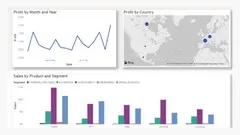
Database Design and Operational Business Intelligence 
Businesses can use data modelling and manipulation techniques to improve decision-making and gain insights into their operations through the use of database design and operational business intelligence. This course provides the necessary tools to make the most of data and drive success. ▼
ADVERTISEMENT
Course Feature
![]() Cost:
Cost:
Free Trial
![]() Provider:
Provider:
Coursera
![]() Certificate:
Certificate:
No Information
![]() Language:
Language:
English
Course Overview
❗The content presented here is sourced directly from Coursera platform. For comprehensive course details, including enrollment information, simply click on the 'Go to class' link on our website.
Updated in [March 06th, 2023]
This course provides an introduction to database design and operational business intelligence. Students will develop a thorough understanding of data warehouse design and data manipulation. They will learn how to create an Entity Relationship Diagram (ERD) that shows the progression from conceptual to logical to physical design.
The course will cover the fundamentals of business intelligence (BI) and its role in data analysis. Students will learn how to use SQL coding to query and manipulate data, as well as how to use data mining models and data visualisation techniques to gain insights from data.
The course will also cover the basics of data warehousing, including the different types of data warehouses, the components of a data warehouse, and the process of designing and building a data warehouse. Students will learn how to use data warehouse tools to create and manage data warehouses.
At the end of the course, students will be able to design and build a data warehouse, query and manipulate data, and use data mining models and data visualisation techniques to gain insights from data. They will also be able to create an ERD that shows the progression from conceptual to logical to physical design.
[Applications]
After completing this course, students should be able to apply their knowledge of database design and operational business intelligence to their own projects. They should be able to create an ERD that shows the progression from conceptual to logical to physical design, as well as use SQL coding, data mining models, and data visualisation to analyse data. Additionally, they should be able to explain what business intelligence (BI) is and what it does.
[Career Paths]
1. Database Administrator: Database Administrators are responsible for the design, implementation, maintenance, and security of databases. They ensure that data is stored securely and efficiently, and that it is accessible to users. As technology advances, Database Administrators must stay up-to-date on the latest trends and technologies in order to ensure the security and reliability of their databases.
2. Business Intelligence Analyst: Business Intelligence Analysts are responsible for analyzing data and providing insights to help organizations make better decisions. They use data mining, predictive analytics, and other techniques to uncover trends and patterns in data. They must be able to interpret and communicate their findings to stakeholders in order to help them make informed decisions.
3. Data Scientist: Data Scientists are responsible for collecting, analyzing, and interpreting large amounts of data. They use a variety of techniques, such as machine learning, to uncover insights from data. They must be able to communicate their findings to stakeholders in order to help them make informed decisions.
4. Data Engineer: Data Engineers are responsible for designing, building, and maintaining data pipelines. They must be able to design efficient data architectures and develop ETL processes to ensure data is collected, stored, and processed correctly. As technology advances, Data Engineers must stay up-to-date on the latest trends and technologies in order to ensure the reliability of their data pipelines.
[Education Paths]
1. Bachelor of Science in Computer Science: This degree program provides students with a comprehensive understanding of computer science fundamentals, including programming, software engineering, and database design. Students will also learn about the latest trends in data science, such as machine learning, artificial intelligence, and big data analytics.
2. Master of Science in Business Intelligence: This degree program focuses on the application of data science to business operations. Students will learn how to use data to make informed decisions, develop strategies, and optimize processes. They will also gain experience in data mining, data visualization, and predictive analytics.
3. Master of Science in Data Science: This degree program provides students with a comprehensive understanding of data science principles and techniques. Students will learn how to use data to solve complex problems, develop predictive models, and create data-driven solutions. They will also gain experience in machine learning, artificial intelligence, and big data analytics.
4. Doctor of Philosophy in Data Science: This degree program provides students with an in-depth understanding of data science principles and techniques. Students will learn how to use data to solve complex problems, develop predictive models, and create data-driven solutions. They will also gain experience in machine learning, artificial intelligence, and big data analytics.
Course Syllabus
The Nature of Data and Relational Database Design
Data Warehousing and Business Intelligence
Business Intelligence and Visual Analytics
Course Provider

Provider Coursera's Stats at AZClass
Discussion and Reviews
0.0 (Based on 0 reviews)
Explore Similar Online Courses

Build and Optimize Data Warehouses with BigQuery

Environmental Challenges: Justice in Natural Resource Management - Online Course

Python for Informatics: Exploring Information

Social Network Analysis

Introduction to Systematic Review and Meta-Analysis

The Analytics Edge

DCO042 - Python For Informatics

Causal Diagrams: Draw Your Assumptions Before Your Conclusions

Whole genome sequencing of bacterial genomes - tools and applications

Business Intelligence Analyst - Power BI Tableau

Create BI Reports with Power BI Using Excel Data

Fundamental Question on Business Intelligence
 Related Categories
Related Categories
 Popular Providers
Popular Providers
Quiz
 Submitted Sucessfully
Submitted Sucessfully
1. What is the main purpose of this course?
2. What is the first step in the design process of a data warehouse?
3. What is the main benefit of business intelligence?
4. What is the purpose of Business Intelligence (BI)?
Correct Answer: To analyse data and provide insights to inform business decisions.


Start your review of Database Design and Operational Business Intelligence